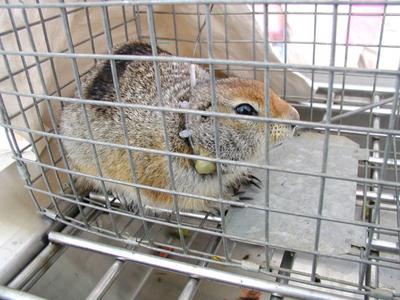8 May, 2002
Guest Appearances
We had quite a bit of lab work to do today, so rather than going over the lab
procedures with this entry, I wanted to introduce you to our fourth team
member and a couple of the other people working here at Toolik.
The first introduction is for Dr. Brian Barnes. Brian is a professor with the
Institute of Arctic Biology at The University of Alaska-Fairbanks. In fact
Brian is currently the interim director of the institute. In addition to his
duties at the university, Brian is the science director of the Toolik Lake
research facility. Brian started his academic career with a bachelor's degree
from the University of California-Riverside. Brian then became
Dr. Barnes after completing graduate work at the University of Washington.
Brian has been with the University of Alaska for the past fifteen years.
The primary emphasis or Dr. Barnes' lab is the adaptation of animals to
arctic conditions. The subjects of study range from cold tolerance of small
insects to the hibernation patterns of grizzly bears. Here at Toolik Lake,
our project with insect adaptations runs side by side with a study of arctic
ground squirrels.
Following the study of the ground squirrels was a most interesting part of
the day today. The study is looking at many aspects of hibernation and behavior in the
squirrels that might be different from their non-polar cousins. This includes
food storage for colder months, weight gain, physiological changes, fur
density, reproductive status and above ground vs. below ground behaviors. The
wide range of the study provides research work for two graduate students and
one undergraduate as well as Dr. Barnes. The graduate student currently here
in Toolik is Tim Martin. Tim came to Alaska from southern California to get a
change of scenery and is working on his Master's Degree. Today, Tim became
one of my heroes. Since I arrived in Toolik, I have been attempting the
photograph a squirrel that lives right outside our lab trailer. Every time I
get within photo range, she quickly ducks back into her den under the rocks.
This little squirrel has been taunting me like this for days. Today, Tim
caught the squirrel in a live trap and brought her in. As I was introduced to
my tormentor, I learned that her study name is Dash. She is a very healthy
reproductive female arctic ground squirrel.
A portion of the study requires that local squirrels be periodically trapped
and measured for health and reproductive status. At the time they are brought
in, they are anesthetized, fitted with a small radio collar and marked with
a hair dye for identification (Tim uses Clairol Nice & Easy). With the radio
collar, their movements above and below ground can be studied throughout the
year. Tim was able to trap and check three squirrels today. One required a
new collar and all were healthy. There are approximately 30 squirrels
currently being tracked around Toolik Lake. Some of the findings so far
include some interesting results with the squirrels' temperature
sensitivities. The squirrels seem to have as great a need for their burrows
in warm temperatures as well as cold. Squirrels only leave their burrows
within a given range. As soon as the air temperatures get slightly too warm
or slightly too cold, they head right back into their dens for the relatively
moderate temperatures of the underground.
One aspect of the study that fascinates me is an idea that young squirrels
can delay sexual maturation if they do not at an acceptable weight in the
early spring. Rather than using energy for the reproductive process, these
squirrels, called "red shirts" concentrate on becoming big and healthy and
ready to reproduce in the following year. The idea that temperatures and body
mass can control hormone regulation has many interesting application.
Later in the day, today, I was also introduced to the research of Dr. Steve
Oberbauer of Florida International University. Steve studies the adaptations
of plants to extreme environmental conditions. We are currently running some
of Dr. Oberbauer's plants through our lab to check for antifreeze proteins.
Steve's research here at Toolik has shown that plants have the ability to
photosynthesize even under a layer of snow. Some light passes through the
snow up to a depth of about 20 cm. In the arctic environment it can be a he
advantage if plants can begin to produce energy for growth even before the
snow cover is gone. An early jump on spring growth as the snow begins to melt
can make an enormous difference for a plant's long-term survival.
These two research projects are just examples of how much I've been learning
with this program. With so much fascinating work going on while the camp is
barely open, I cannot imagine how much amazing work goes on here during peak
research times in the summer.
Tomorrow, we head back south (if the roads allow) and stop to collect insects
near the town of Wiseman. Tomorrow will be another new experience and another
day of learning something new.

This is Dash. The squirrel that has been taunting me for days. --
Contact the TEA in the field at
.
If you cannot connect through your browser, copy the
TEA's e-mail address in the "To:" line of
your favorite e-mail package.
|
